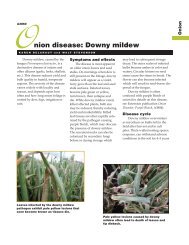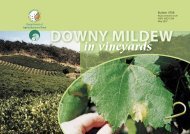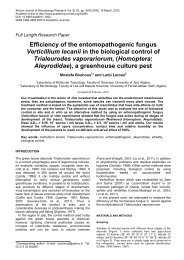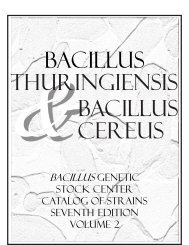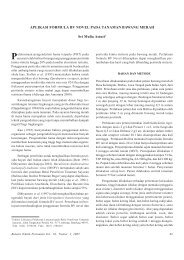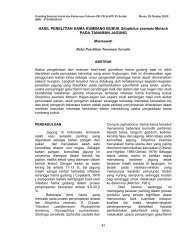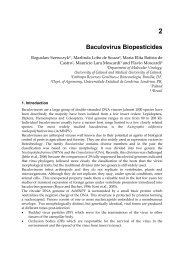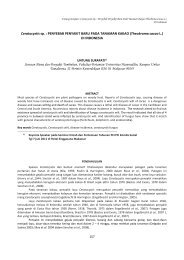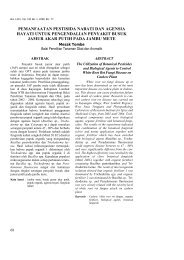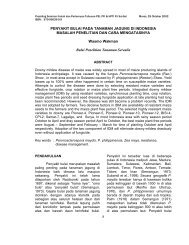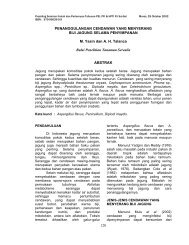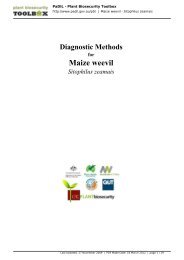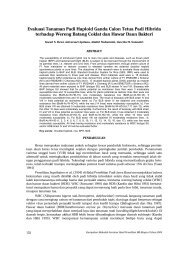biological characteristics and pathogenicity of verticillium ...
biological characteristics and pathogenicity of verticillium ...
biological characteristics and pathogenicity of verticillium ...
You also want an ePaper? Increase the reach of your titles
YUMPU automatically turns print PDFs into web optimized ePapers that Google loves.
Pak. Entomol. Vol. 29, No.2, 2007<br />
BIOLOGICAL CHARACTERISTICS AND PATHOGENICITY OF VERTICILLIUM LECANII<br />
AGAINST BEMISIA TABACI (HOMOPTERA: ALEYRODIDAE) ON EGGPLANT<br />
Lazreg Fatiha, Shaukat Ali, Shunxiang Ren <strong>and</strong> Muhammad Afzal*<br />
College <strong>of</strong> Natural Resources <strong>and</strong> Environment, South China Agric. University, Guangzhou 510642, China<br />
*Department <strong>of</strong> Agri. Entomology, University <strong>of</strong> Agriculture, Faisalabad, Pakistan<br />
ABSTRACT<br />
Four strains <strong>of</strong> Verticillium lecanii (Zimmermann) Viegas (V20, V26, V07 <strong>and</strong> V17) were tested for the<br />
<strong>biological</strong> <strong>characteristics</strong> <strong>and</strong> <strong>pathogenicity</strong> against Bemisia tabaci. The four strains were morphologically<br />
compared at three different artificial media (SDAY, PDA <strong>and</strong> CZAPECK-DOX) under laboratory conditions<br />
at 25± 2 ο C, 80±5% RH <strong>and</strong> 16:8h (L: D). The four isolates were significantly different from each other. The<br />
isolate V20 showed the greatest potential in mycelium growth rate than other three strains. The highest<br />
(0.37cm.day -1 ) <strong>and</strong> the lowest (0.161cm.day -1 ) colony growth rates were associated with V20 <strong>and</strong> V17<br />
respectively cultured on SDAY <strong>and</strong> CZAPEK respectively. SDAY is the best media for the sporulation <strong>of</strong> four<br />
strains. The isolate V20 showed the highest sporulation (32.75x10 7 conidia mL -1 ) <strong>and</strong> the isolate V17 showed<br />
lowest sporulation (3.45 x10 7 conidia mL -1 ) during the present investigation. Pathogenicity test at saturated<br />
humidity showed that the third instar is very susceptible to fungal infection. The virulence is significantly<br />
different. The LC 50 values for third instars were 1.65 x10 7 , 1.87 x10 7 , 2.2 x10 7 <strong>and</strong> 2.58x10 7 conidia/ml for<br />
isolate V20, V26, V07 <strong>and</strong> V17 respectively. The least <strong>and</strong> highest LT 50 values were 2.909 <strong>and</strong> 3.534 noted for<br />
isolate V20 <strong>and</strong> V17 respectively. The isolate V20 is more virulent on third instar <strong>of</strong> Bemisia tabaci compare<br />
with other isolates.<br />
Key words: Verticillium lecanii, Bemisia tabaci, growth rate, sporulation, <strong>pathogenicity</strong><br />
INTRODUCTION<br />
Bemisia tabaci (Gennedius) has become a serious<br />
world-wide pest since the early 80s (Gerling, 1990).<br />
Since it first recorded by Chou (1949) in china B.<br />
tabaci was considered as a non-severe pest until mid<br />
1990s (Ren et al., 2001) when sporadic outbreak<br />
occurred affecting a wide range <strong>of</strong> host plants. The<br />
outbreak <strong>of</strong> the pest in china 1990s is thought to<br />
have originated from the invasion <strong>of</strong> the new B-<br />
biotype on ornamentals crops (Qiu et al., 2003), it<br />
attacks 176 plant species <strong>and</strong> is considered as a<br />
severe pest on vegetables, field crops <strong>and</strong><br />
ornamental plant <strong>and</strong> fruits( Ren et al., 2001). Direct<br />
damage occurs as a result <strong>of</strong> sucking plant saps from<br />
phloem leading to physiological disorders such as a<br />
wilting, stunted growth <strong>and</strong> irregular ripening <strong>of</strong><br />
fruits (Oliviera et al., 2001). As an alternative to<br />
chemical control, the use <strong>of</strong> natural enemies which<br />
include a wide range <strong>of</strong> predators, parasitoids <strong>and</strong><br />
pathogens, is considered an appropriate <strong>and</strong><br />
plausible measure to control B. tabaci.<br />
To control arthropods <strong>and</strong> more than 750 fungi from<br />
90 species have described as entomopathogenic<br />
against insects species up to date. Verticillium<br />
lecanii is a very common fungal species, which was<br />
firstly described by Zimmermann (Zimmermann,<br />
1898), in c<strong>of</strong>fee scale insects in Java. It was capable<br />
<strong>of</strong> infecting a wide range <strong>of</strong> insect hosts from board<br />
geographical <strong>and</strong> climatic locations. Like all<br />
microorganisms, entomopathogenic fungi have<br />
specific <strong>biological</strong> <strong>characteristics</strong> that influence their<br />
activity in the environment (Parker et al., 2003). To<br />
select fungal pathogen for controlling whiteflies it is<br />
necessary to study simple basic <strong>characteristics</strong> that<br />
are required to kill the target insects in both field <strong>and</strong><br />
greenhouse conditions. According to Moore <strong>and</strong><br />
Prior (1993) relevant <strong>characteristics</strong> were identified<br />
as good mass production features such as high<br />
sporulation on artificial media, high virulence<br />
against the target organisms <strong>and</strong> the ability to<br />
63
Pak. Entomol. Vol. 29, No.2, 2007<br />
withst<strong>and</strong> the environment in which the pest is<br />
occurring. Fungal isolates with rapid germination<br />
<strong>and</strong> hyphal growth rates have an advantage as<br />
<strong>biological</strong> control agents because host infection can<br />
potentially occur much more quickly (Hadjeck <strong>and</strong><br />
Leger, 1994; Varela <strong>and</strong> Morales, 1996). Mor et al<br />
(1996) compared 35 strains <strong>of</strong> V. lecanii from<br />
different hosts <strong>of</strong> geographical location against B.<br />
tabaci <strong>and</strong> found that the virulence on larvae <strong>of</strong> B.<br />
tabaci within these isolates ranged from 0 to 83%.<br />
Further study <strong>of</strong> these strains <strong>of</strong> V. lecanii against B.<br />
argentifolii (biotype B <strong>of</strong> B. tabaci) classified the 35<br />
V. lecanii strains for degree <strong>of</strong> the virulence.<br />
Pathogenicity <strong>of</strong> V. lecanii involves adhesion <strong>of</strong><br />
spores to the insect cuticle, germination, penetration<br />
<strong>and</strong> internal colonization culminating in host death<br />
(Gindin et al., 1994).Insect mortality is effected<br />
when the fungus gain entry into the haemoceol by<br />
penetrating the host cuticle by combination <strong>of</strong><br />
hydrolytic enzymes <strong>and</strong> mechanical force. The<br />
morphology <strong>of</strong> the insect stage may somehow<br />
influence fungal infection (Wriaght et al., 2000).<br />
Our studies were aimed at developing a laboratory<br />
bioassay system for efficient assessment <strong>of</strong> fungal<br />
biocontrol agent against B. tabaci. The four strains<br />
<strong>of</strong> V. lecanii derived from same geographical<br />
location <strong>and</strong> originated from the same host pest<br />
(Trialeurodes sp.) were compared morphologically<br />
by culturing them on different media. These strains<br />
were also compared for their <strong>pathogenicity</strong> against<br />
third instar <strong>of</strong> B. tabaci to search for highly ovicidal<br />
isolate for further study for microbial control <strong>of</strong><br />
whitefly pests.<br />
MATERIALS AND METHODS<br />
Plant materials<br />
Eggplant Solanum melongena var. dafeng L. were<br />
grown individually in plastic pots (16cm diameter).<br />
The pots were placed inside cages (60×60×60 cm)<br />
under laboratory condition having 25 ± 2 ο C, 65±5%<br />
R.H <strong>and</strong> 16:8 (L: D) light period. Water <strong>and</strong><br />
fertilizer were supplied as per requirement <strong>of</strong> the<br />
plants. The plants were used for the experiments at<br />
4-6 leaf stage.<br />
Fungal strains, insect <strong>and</strong> media<br />
Table 1. Composition <strong>of</strong> different media used to study <strong>biological</strong> <strong>characteristics</strong> <strong>of</strong> V.lecanii<br />
Four strains <strong>of</strong> V. lecanii(V07, V17, V20 <strong>and</strong> V26),<br />
used during this study, were obtained from Fujian<br />
Agricultural <strong>and</strong> Forestry University, China. These<br />
strains were isolated from Trialeurodes sp.<br />
B. tabaci used in this experiment were obtained from<br />
laboratory <strong>of</strong> Insect Ecology South China<br />
Agricultural University (SCAU), Guangzhou China,<br />
reared in greenhouse under non-insecticidal <strong>and</strong> non<br />
infective conditions. The adults were collected with<br />
aspirator <strong>and</strong> released onto eggplant placed inside a<br />
cage (60×60×60 cm) containing four eggplants<br />
having 25 ± 2 ο C temperature, 65±5% R.H. <strong>and</strong> 16:8<br />
(L: D) light period. After 24 h all adults were<br />
expelled out from the cages. The eggs were cultured<br />
until the development <strong>of</strong> third instar.<br />
Three different growth media (SDAY, PDA <strong>and</strong><br />
Czapek-Dox), were used to study the <strong>biological</strong><br />
<strong>characteristics</strong> <strong>of</strong> four V. lecanii isolates. (Table 1)<br />
Media Composition Carbon source Status<br />
200g potatoes (infusion)<br />
Dextrose<br />
Original formulation<br />
PDA<br />
20g dextrose<br />
20g Agar<br />
3g yeast extract<br />
Glucose<br />
Original formulation<br />
SDA<br />
10g Glucose<br />
10g Peptone<br />
20g Agar<br />
CZAPEK<br />
30g Sucrose<br />
30g Sodium nitrate<br />
1g dipotassium phosphate<br />
0.5g Magnesium Sulfate<br />
0.5g PotassiumChoride<br />
0.01g Ferrous Sulfate<br />
20g Agar<br />
Sucrose<br />
Original formulation<br />
64
Pak. Entomol. Vol. 29, No.2, 2007<br />
Biological <strong>characteristics</strong> <strong>of</strong> Verticillium lecanii<br />
6 ml <strong>of</strong> each medium was poured into Petri dishes<br />
(7.5 cm in Ø). The concentration <strong>of</strong> suspension used<br />
was approximately 1×10 6 spores/ml. Then, 1µl <strong>of</strong><br />
suspension was inoculated in the centre <strong>of</strong> the three<br />
different media plates. The plates were incubated at<br />
25±2 ο C, 80±5% RH <strong>and</strong> 16:8h (L: D). There were<br />
four plates in each treatment. The measurements <strong>of</strong><br />
colony diameter were taken after 5, 10, 15 <strong>and</strong> 20<br />
days <strong>of</strong> incubation. The diameter <strong>of</strong> every colony<br />
was the means <strong>of</strong> long <strong>and</strong> short diameter. Spore<br />
production was investigated after 20 days <strong>of</strong><br />
culturing. Conidia from the four plates in each<br />
treatment were dislodged by gently scarping with a<br />
sterile blade into 500 mL 0.01% Tween 80 <strong>and</strong><br />
agitated for 10 min. Then, the number <strong>of</strong><br />
conidiospores was determined using a<br />
hemocytometer under microscope. Thereupon, the<br />
spores production in 1 ml medium was evaluated.<br />
The data were subjected to F-test <strong>and</strong> LSD test by<br />
means <strong>of</strong> SAS 8.1 s<strong>of</strong>tware (SAS, 2000).<br />
Pathogenicity against Bemisia tabaci<br />
After the passage <strong>of</strong> the fungus through B. tabaci,<br />
the V. lecanii strains were cultured on SDAY media.<br />
Application <strong>of</strong> V. lecanii was made with aqueous<br />
suspension <strong>of</strong> 15 days old conidia. The series <strong>of</strong><br />
suspension tested was 1×10 4 , 1×10 5 , 1×10 6 , 1×10 7<br />
<strong>and</strong> 1×10 8 spores/ml. The blastospores were<br />
quantified using a st<strong>and</strong>ard hemacytometer at 40x<br />
magnification. The viability <strong>of</strong> fungi was determined<br />
by using st<strong>and</strong>ard techniques (Goettel <strong>and</strong> Inglis,<br />
1997). Spores viability was determined by culturing<br />
0.1ml aliquot <strong>of</strong> the stock suspension onto three<br />
potato dextrose agar (PDA) plates amended with<br />
0.005% benomyl. The plates were incubated at 25<br />
ο C for 24h. 300 spores were examined <strong>and</strong> scored<br />
for viability (Goettel <strong>and</strong> Inglis, 1997).<br />
Leaves with B. tabaci (>100 nymph/leaf) were used<br />
for the test. The leaves were immersed into 20ml<br />
spore suspension for 10 s, while control leaves were<br />
immersed into 0.01% Tween 80 for the same period.<br />
After air-dryness, the treated leaves were cultured at<br />
25±2 ο C, 90±5% RH <strong>and</strong> 16:8h (L: D) <strong>and</strong> sealed for<br />
2 days into bags to maintain the humidity around the<br />
leaves. There were four leaves in each treatment.<br />
Mortality <strong>of</strong> B. tabaci was surveyed under a<br />
binocular microscope every day from the 2nd day<br />
after inoculation. In order to identify if infected by<br />
V. lecanii, the dead whiteflies were transferred to<br />
wet filters paper. For colony growth <strong>and</strong> sporulation<br />
the scales were cultured on SDYA media, if mycelia<br />
<strong>and</strong> conidia <strong>of</strong> V. lecanii were observed the insect<br />
was decided to be died from infection. The mortality<br />
data was subjected to probit analysis to calculate<br />
LC 50 <strong>and</strong> LT 50 values (Gindin et al., 2000).<br />
The data were analyzed with the model <strong>of</strong> timedose-mortality<br />
(TDM) to calculate LC 50 <strong>and</strong> LT 50<br />
values. The DPS (Data Processing System) s<strong>of</strong>tware<br />
(Tang <strong>and</strong> Feng 2002) was employed.<br />
RESULTS<br />
Effect <strong>of</strong> culture media on colony size <strong>of</strong> V. lecanii<br />
The results <strong>of</strong> mycelial growth on different media<br />
incubated at 5, 10, 15 <strong>and</strong> 20 days have been<br />
presented in Table-2. The highest <strong>and</strong> least mycelia<br />
diameters after 5 days were recorded for isolates<br />
V20 <strong>and</strong> V17 on media <strong>of</strong> SDAY <strong>and</strong> Czapek-Dox<br />
with values <strong>of</strong> 1.75 <strong>and</strong> 1.3 cm respectively. At 20<br />
days incubation period, the highest <strong>and</strong> least values<br />
were associated with isolates V20 <strong>and</strong> V17 on the<br />
SDAY, PDA <strong>and</strong> Czapek-Dox with the values 7.23,<br />
6.2, 5.43, 5.28, 5.13 <strong>and</strong> 4.92 cm respectively.<br />
Results were subjected to analysis <strong>of</strong> variance tests<br />
at P
Pak. Entomol. Vol. 29, No.2, 2007<br />
an average 5.43, 5.26 cm <strong>and</strong> V17, V07 were 4.43,<br />
4.92 cm respectively under laboratory condition <strong>of</strong><br />
25± 2 ο C. The strains differed significantly in growth<br />
depending on culture media (F=91.91; df=2;<br />
P=0.002). For all the isolates SDAY was the best<br />
media for the growth <strong>and</strong> the strain V20 showed the<br />
highest growth rate than V17 that shown the lowest.<br />
Table 2. Effects <strong>of</strong> media on mycelial growth <strong>of</strong> different V. lecanii strains<br />
Strains Media<br />
Diameters <strong>of</strong> colonies (cm)<br />
5 d 10 d 15 d 20 d<br />
SDAY 1.75±0.04a 3.53±0.11a 5.38±0.02a 7.23±0.06a<br />
V20 PDA 1.61±0.06bc 3.30±0.10bc 4.85±0.06bc 6.20±0.09bc<br />
Czapek-Dox 1.46±0.07d 3.08±0.05de 4.23±0.05d 5.43±0.03d<br />
SDAY 1.65±0.04d 3.41±0.08ab 4.95±0.17b 6.25±0.20b<br />
V26 PDA 1.57±0.03c 3.21±0.09cd 4.68±0.12c 5.94±0.05c<br />
Czapek-Dox 1.43±0.05de 3.03±0.05e 4.16±0.25d 5.26±0.25de<br />
SDAY 1.36±0.06fg 3.10±0.14de 3.48±0.04e 5.02±0.03ef<br />
V07 PDA 1.33±0.03fg 2.88±0.06f 3.31±0.17ef 4.93±0.02f<br />
Czapek-Dox 1.32±0.04g 2.25±0.05h 2.93±0.48g 4.43±0.12g<br />
SDAY 1.47±0.09d 3.30±0.11bc 4.25±0.05d 5.27±0.12de<br />
V17 PDA 1.43±0.03de 3.13±0.05de 4.25±0.05d 5.13±0.02ef<br />
Czapek-Dox 1.39±0.03ef 2.68±0.16g 3.21±0.10f 4.92±0.5f<br />
*Means in the same column followed by the same letter are not significantly different (P < 0.05) by LSD test.<br />
Effect <strong>of</strong> culture media on Sporulation <strong>of</strong> V.<br />
lecanii<br />
Results indicated that four strains <strong>of</strong> V. lecanii can<br />
produce abundant spores in solid state media<br />
culture. All the media provided sporulation 1x10 7<br />
conidia ml -1 when 0.03%tween 80 was used to<br />
dislodge the spores from twenty days old colonies<br />
(Figure 1). In this trail an initial spore<br />
concentration <strong>of</strong> 1x10 6 conidia ml -1 was cultured<br />
on three culture media. The sporulation rate was<br />
significantly influenced by culture media<br />
(F=220.38; df= 2; p= 0.024). Significant difference<br />
was also observed for isolates (F= 174.71; df= 3;<br />
Sp o r u l a t i o n r a t e<br />
40<br />
35<br />
30<br />
25<br />
20<br />
15<br />
10<br />
5<br />
0<br />
V20 V26 V07 V17<br />
Isolates<br />
p=0.004). The means values <strong>of</strong> sporulation after 20<br />
days are given in table-3. The highest sporulation<br />
was observed for isolate V20 cultured on SDAY<br />
with value 32.75 x10 7 conidia ml -1 , SDAY media<br />
was noticed as the best media for sporulation <strong>of</strong> all<br />
the isolate. Lowest value was recorded on Czapek-<br />
Dox with a value <strong>of</strong> 4.12 x10 7 conidia ml -1 for V20.<br />
Generally the sporalution was observed to be<br />
higher for the four isolate on SDAY <strong>and</strong> PDA <strong>and</strong><br />
low on Czapek-Dox. Least value was noted for the<br />
isolate V17 on SDAY <strong>and</strong> Czapek-Dox media with<br />
3.45 x10 7 <strong>and</strong> 0.60 x10 7 conidia ml -1 respectively.<br />
SDAY<br />
PDA<br />
CZAPEK_-DOX<br />
Fig-1: Effect <strong>of</strong> different media on sporulation rate (1×10 7 conidia / ml -1 ) <strong>of</strong> different isolate <strong>of</strong> V. lecanii<br />
66
Pak. Entomol. Vol. 29, No.2, 2007<br />
Pathogenicity against third instars nymphs <strong>of</strong> B.<br />
tabaci<br />
The mortality caused by different isolates <strong>of</strong> V.<br />
lecanii on the third instar is presented in Table-3. B.<br />
tabaci mortality was significantly different between<br />
the different isolates varying from 87% to 56.19%<br />
(F= 12.21, df=3 <strong>and</strong> P=0.024), however the four<br />
strains were pathogenic against third instar at<br />
different concentrations. The isolate V20 was more<br />
virulent than other strains, whereas V26 isolate<br />
displayed similar level <strong>of</strong> virulence but statistically<br />
differed from V20. The lowest mortality was<br />
observed for V17 <strong>and</strong> V07. These results revealed<br />
that strains <strong>of</strong> V. lecanii derived from the same pest<br />
<strong>and</strong> same geographical location have different<br />
virulence against third instar <strong>of</strong> B. tabaci.<br />
The insect mortality started to increase 6 days after<br />
the inoculation <strong>and</strong> cumulative mortality was highest<br />
after 8 days. 5 days post treatment the lethal time<br />
required for 50% mortality varied for among the<br />
isolates. The isolate V20 had shortest LT 50 value <strong>of</strong><br />
5.69d at the concentration 1×10 8 <strong>and</strong> 6.22 at 10 7<br />
while isolate V17 showed the highest LT 50 value <strong>of</strong><br />
8days. The LT 50 for V26 was 6.11 days at 10 8 <strong>and</strong><br />
6.69 days at 1×10 7 conidia/ml whereas the LT 50 for<br />
V07 was 6.65 at 10 8 <strong>and</strong> was 7.47 at 10 7 . The LC 50<br />
values were 1.07x10 6 (Pearson chi-square Test;<br />
2 =8.83862, df=23, P=0.99792, Hosmer<br />
&Lemeshow Test, 2 =4.4573, df=9, P=0.87883),<br />
1.19 x10 7 (Pearson chi-square Test; 2 =10.7846,<br />
df=23, P=0.9905, Hosmer & Lemeshow Test,<br />
2 =4.8780, df=9, P=0.8448)1.30x10 8 (Pearson chisquare<br />
Test; 2 =5.69818, df=19, P=0.99925,<br />
Hosmer & Lemeshow Test, 2 =1.0223, df=8,<br />
P=0.99810) <strong>and</strong> 5.08 x10 8 (Pearson chi-square Test;<br />
2 =3.35081, df=19, P=0.99999, Hosmer &<br />
Lemeshow Test, 2 =1.0476, df=8, P=0.99793) for<br />
V20, V26, V07<strong>and</strong> V17 respectively (Table-4).<br />
LC 90 Values for V20 <strong>and</strong> V17 were 3.67 x10 9 <strong>and</strong><br />
7.69x10 10 conidial/ml respectively where as LC 90<br />
value for V26 was 1.41x10 10 conidial/ml.<br />
Table 3. Cumulative mortality <strong>of</strong> B. tabaci after 8 days caused by different isolates at different<br />
concentrations <strong>of</strong> V. lecanii on eggplant<br />
V. lecanii concentrations (conidia/ml)<br />
Isolates 10 4 10 5 10 6 10 7 10 8<br />
V20 60.66±5.11 cA 62.63b±1.15 cA 64.64±3.73 b cA 72.00±9.23 abA 87±1.73 aA<br />
V26 42.00±1.15 bA 49.92±1.44 bA 51.34±9.11 bAB 56.54±11.75 abA 78.57±6.96 aAB<br />
V07 28.28±3.72 bB 34.59±7.24 bB 38.79±11.36 bB 51.93±9.40 abA 74.30±1.66 aB<br />
V17 23.84±1.48 cB 32.11B±3.38 bC 35.15±1.81abcB 42.06±12.01 abA 56.19±1.04 aC<br />
df 3 3 3 3 3<br />
F 14.04 12.06 2.61 1.36 12.21<br />
P 0.0015 0.0024 0.1232 0.3218 0.024<br />
*Mean in the same row with same small letters are not significantly different from each other (DMRT,<br />
P
Pak. Entomol. Vol. 29, No.2, 2007<br />
DISCUSSION<br />
Morphological <strong>characteristics</strong>, commonly evaluated,<br />
include colony appearance, shape <strong>and</strong> size <strong>of</strong><br />
conidia. Such <strong>characteristics</strong> may not be important in<br />
the separation <strong>of</strong> isolates (Hadjek <strong>and</strong> Leger, 1994).<br />
Several studies have found morphological<br />
<strong>characteristics</strong> <strong>of</strong> little use in the selection <strong>of</strong><br />
entomogenous fungi for biocontrol (Hajek <strong>and</strong><br />
Leger, 1994; Varela <strong>and</strong> Morales, 1996). However,<br />
morphological <strong>characteristics</strong> could be associated<br />
with physiological <strong>and</strong> pathogenic <strong>characteristics</strong><br />
(Hall, 1984; Jackson et al., 1985). Surface culture is<br />
used for the routine maintenance <strong>of</strong> isolates <strong>and</strong> for<br />
production <strong>of</strong> conidia. One <strong>of</strong> the most commonly<br />
used media by insect pathologists is Sabourauds<br />
Dextrose Agar supplemented with yeast extract<br />
(SDA); however many other media such as<br />
cornmeal, Czapeck-Dox, malt extract, potato<br />
dextrose agar (PDA), <strong>and</strong> Sabourauds maltose agar<br />
have also been used <strong>of</strong>tenly. Some researchers<br />
advocate more complex media such as mixed cereal<br />
agar claiming that there is less chance <strong>of</strong> loss <strong>of</strong><br />
vigor when such media are used. However, this<br />
media has not been substantiated <strong>and</strong> this media has<br />
not been widely accepted in insect pathology (Lacey,<br />
1994). Gottel et al (2000) mentioned that the<br />
addition <strong>of</strong> potato extract to a culture medium<br />
supplies nutrient such as starch, minerals mainly Ca,<br />
K, Ca, P, Mg Na, S, Zn, N, crude proteins <strong>and</strong><br />
vitamins needed by the fungus.<br />
Many <strong>of</strong> the classical <strong>and</strong> cosmopolitan<br />
entomopathogenic fungi, Beauveria bassiana, M.<br />
anisoplaie <strong>and</strong> N. rileyi are most easy to grow on<br />
st<strong>and</strong>ard agar media <strong>and</strong> can be commercially<br />
produced as mycoinsecticides. For small scale<br />
inoculums productions where economics are not a<br />
primary concern, relatively expensive media such as<br />
Sabouraud Dextrose Agar <strong>and</strong> Potato Dextrose Agar<br />
have been used successfully to induce sporulation<br />
<strong>and</strong> obtain inoculums <strong>of</strong> several entomopathogenic<br />
fungi. Then the common technique for cultivation <strong>of</strong><br />
fungal spores is either a surface culture with a solid<br />
substrate (moistened wheat bran, millet or rice), or a<br />
submerged culture with a liquid medium (Feng et<br />
al., 2000). Most facultative entomogenous fungi will<br />
grow on one or more defined or semi-defined garbased<br />
medium or on natural substrates. Specialist<br />
fungi are usually fastidious on artificial media <strong>and</strong><br />
are usually best maintained on their respective hosts.<br />
A few can be grown in vitro but require a complex<br />
media. For example, Lagenidium giganteum can be<br />
cultivated on simple medium but requires sterols to<br />
induce oasorogenesis (Navon <strong>and</strong> Ascher, 2000).<br />
However in case <strong>of</strong> V. lecanii conidiation occurs<br />
without starvation <strong>of</strong> the mycelium <strong>and</strong> factors<br />
contributing to the onset <strong>of</strong> conidiation in V. lecanii<br />
have not been elucidated the ability <strong>of</strong> M. anisoplaie,<br />
B. bassiana <strong>and</strong> V. lecanii to grow <strong>and</strong> produce<br />
conidia on artificial media is one <strong>of</strong> the main<br />
advantages in the commercial development <strong>of</strong> these<br />
fungi. These organisms are also amicable to<br />
molecular <strong>and</strong> biochemical laboratory investigations<br />
(Bidochka et al., 2000). A. aleyrodis isolates are<br />
mostly cultivated on different kinds <strong>of</strong> media<br />
ranging from solid grain media to water agar (Liu et<br />
al., 2002). V. lecanii can produce abundant spores in<br />
solid media state culture (Feng et al., 2000).<br />
All the isolates tested proved to be pathogenic to the<br />
third instar <strong>of</strong> B. tabaci however several isolates <strong>of</strong><br />
V. lecanii were virulent again B. tabaci (Gindin et<br />
al., 2000; Wang, 2004). Jackson et al. (1989) tested<br />
18 strains V. lecanii for virulence against the aphid<br />
Macrosiphoniella sanborni (Gillette) <strong>and</strong> a wide<br />
variation in virulence among strains was observed.<br />
The most virulent strain had an LT 50 value <strong>of</strong> 3d;<br />
whereas the least virulent strain was almost avirulent<br />
(10% kill in 14d) Lecanicillium muscarium<br />
(formally V. lecanii) was shown to have a high<br />
<strong>pathogenicity</strong> to all developmental stages <strong>of</strong> B.<br />
argentifolii (Gindin et al., 2000). Compared to our<br />
results the best strain V20 had a LT 50 after value <strong>of</strong> 5<br />
days. Wraight et al., (2000) reported that multiple<br />
applications <strong>of</strong> four isolates <strong>of</strong> B. bassiana at rate 1-<br />
2.5x10 3 condia/mm 2 at 4-5 days intervals provided<br />
more than 90% control <strong>of</strong> large (third <strong>and</strong> fourth<br />
instar) nymphs <strong>of</strong> B. argentifollii on cucumber <strong>and</strong><br />
cantaloupe melon. The mortality response <strong>of</strong> B.<br />
tabaci nymphs from the infection with V. lecanii<br />
varied according to developmental stage (L<strong>and</strong>a et<br />
al., 1994). The susceptibility <strong>of</strong> hosts belonging to<br />
different stages also varies in relation to broad<br />
spectrum fungi. Mead <strong>and</strong> Byrne (1991), found no<br />
significant differences in susceptibility to the fungus<br />
due to age or species <strong>of</strong> whitefly <strong>and</strong> reported<br />
infection <strong>of</strong> first to third nymphal instars <strong>of</strong> B. tabaci<br />
strain (B. argentifolii) <strong>and</strong> Trialoreudes<br />
vaporariorium on Poinsettia. The <strong>pathogenicity</strong> <strong>of</strong><br />
V. lecanii has been previousely reported against B.<br />
tabaci although all the isolates tested were<br />
68
Pak. Entomol. Vol. 29, No.2, 2007<br />
pathogenic the third instar <strong>of</strong> B. tabaci. Byrne (1991)<br />
reported that V. lecanii caused 96% mortality on<br />
third instars <strong>of</strong> B. tabaci <strong>and</strong> 95.6% on fourth instars<br />
<strong>of</strong> T. vaporariorum at 21±1°C <strong>and</strong> 89-95% R.H.<br />
There was considerable variation in virulence <strong>of</strong><br />
these strains. The least pathogenic isolate <strong>of</strong> V.<br />
lecanii (V17) caused 50% mortality after 9days.<br />
While the most virulent isolated caused 87% after 8<br />
days. Similar intraspecific variation has been<br />
studied, previously reported with M. anisoplaie<br />
against C. capitata (Ekesi, 2002).<br />
While some studies indicated that strains <strong>of</strong><br />
entomopathogenic fungi more virulent to insect<br />
species from which they were isolated or from<br />
closely species. In our study, the four strains<br />
recovered from the same host <strong>and</strong> the same<br />
geographical location was significantly different for<br />
their virulence against B. tabaci. Direct immersion<br />
<strong>of</strong> the insects in a fungal suspension resulted in the<br />
highest percentage <strong>of</strong> mortality <strong>and</strong> spraying the<br />
broccoli florets produced the lowest levels <strong>of</strong><br />
mortality among all <strong>of</strong> the indirect methods.<br />
Nymphal mortality increased from 22 to 54% when<br />
the immersion time was increased from 5 to 10S<br />
(Liu et al., 2002). Mor et al. (1996) compared 35<br />
strains <strong>of</strong> V. lecanii from different hosts <strong>of</strong><br />
geographical location against B. tabaci <strong>and</strong> found<br />
that the virulence on larvae <strong>of</strong> B. tabaci within these<br />
isolates ranged from 0 to 83%. Further study <strong>of</strong><br />
these strains <strong>of</strong> V. lecanii against B. argentifolii<br />
(biotype B <strong>of</strong> B. tabaci) classified the 35 V. lecanii<br />
strains for degree <strong>of</strong> the virulence.<br />
The differences in the susceptibility <strong>of</strong> different<br />
larval stages to entomopathogens an increased adult<br />
mortality <strong>and</strong> decrease in the reproduction caused by<br />
M. anisoplaie (Malsam, 1999). The third instars <strong>of</strong><br />
Trialeurodes vaporariorium were highly susceptible<br />
to infection by Paecilomyces fumosoroseus <strong>and</strong><br />
Beauveria bassiana on cucumber plant. Detailed<br />
studies on the susceptibility <strong>of</strong> T. vaporariorium to<br />
infection by A. aleyrodis revealed that eggs did not<br />
become infected but first instars nymphs hatching<br />
from those eggs were infected by the conidia<br />
surviving on the leaf surface. Over 90% <strong>of</strong> first <strong>and</strong><br />
second instar nymphs became infected when treated<br />
with 2 ml <strong>of</strong> conidial suspension at a concentration<br />
<strong>of</strong> 4 ×10 6 conidia/ ml applied by means <strong>of</strong> a potter<br />
tower sprayer. The average percentage infection <strong>of</strong><br />
treated third <strong>and</strong> fourth instars nymphs <strong>and</strong> so-called<br />
pupae was 76, 28 <strong>and</strong> 12 respectively (Poprawski et<br />
al., 2000).<br />
The results <strong>of</strong> the present study suggest that V.<br />
lecanii could be considered for the microbial control<br />
<strong>of</strong> B. tabaci. Further studies are now required to<br />
determine <strong>pathogenicity</strong> <strong>and</strong> virulence <strong>of</strong> the isolates<br />
are independently from the original host <strong>and</strong><br />
geographical location.<br />
REFERENCES<br />
Bidochka, D.J., M.J. Melzer, T.M. Lavender <strong>and</strong><br />
A.M. Kamp, 2000. Genetically related isolates<br />
<strong>of</strong> the entomopathogenic fungus Metarhizium<br />
anisoplaie harbour homologous ds RNA<br />
vieuses. Mycol. Res. 104: 1094-1097.<br />
Byrne, D.N. <strong>and</strong> J.R. Bellows, 1991. Whitefly<br />
biology. Annual Review <strong>of</strong> Entomology, 36:<br />
431-457. Chou, I, Listo de la Konatag, 1949.<br />
Aleurodog en cinno. Entomol Sinica, 3: 44-<br />
46.<br />
Ekesi, S., N.K. Maniania <strong>and</strong> S. Lux, 2002.<br />
Mortality in three African tephritid fruit<br />
puparia <strong>and</strong> adults caused by the<br />
entomopathogenic fungi, Metarhizium<br />
anisoplaie <strong>and</strong> Beauveria bassiana. Biocont.<br />
Sci. Technol., 719-729.<br />
Feng, K.C., B.L. Liu <strong>and</strong> Y.M. Tzeng, 2000.<br />
Verticillium lecanii spore production in solidstate<br />
<strong>and</strong> liquid-state fermentations.<br />
Bioprocess Engineering 23: 25-29.<br />
Gindin G., N.U. Geschtovt, B. Raccah <strong>and</strong> I. Brash,<br />
2000. Pathogenicity <strong>of</strong> Verticillium lecanii to<br />
different developmental stages <strong>of</strong> the<br />
silverleaf whitefly, Bemesia argentifolli.<br />
Phytoparasitica, 28: 229-239.<br />
Gindin, G., N.I. Barash <strong>and</strong> B. Raccah, 1994. Effect<br />
<strong>of</strong> endotoxic compounds isolates from<br />
Verticillium lecanii on the sweet potato<br />
whitefly, Bemisia tabaci. Phytoparasitica, 22:<br />
189-196.<br />
Goettel M.S. <strong>and</strong> D. Inglis, 1997. Fungi:<br />
Hyphomycetes. In: Lacey LA, ed. Manual <strong>of</strong><br />
techniques on insect pathology. San Diego,<br />
CA: Academic Press, 213-249 pp.<br />
Goettel, M.S., G.D. Inglis <strong>and</strong> S.P. Wriaght, 2000.<br />
Fungi Hyphomycetes. Manual <strong>of</strong> techniques<br />
in Insect Pathology. Netherl<strong>and</strong>s: Academic<br />
Press, 643-245.<br />
69
Pak. Entomol. Vol. 29, No.2, 2007<br />
Hadjek, A.E. <strong>and</strong> R.J.ST. Leger, 1994. Interactions<br />
between fungal pathogens <strong>and</strong> insect hosts.<br />
Ann. Rev. Ent., 39: 293-322.<br />
Hall, R.A., D. Peterkin <strong>and</strong> B. Ali, 1984. Fungal<br />
control <strong>of</strong> whitefly, Thrips palmi <strong>and</strong><br />
sugarcane froghopper in Trinidad <strong>and</strong> Tabago.<br />
Proceedings <strong>of</strong> the VI Th Intern. Colloquium<br />
Invert. Pathol. Microb. Contr., 1: 177-282.<br />
Hall, R.A., 1980. Effect <strong>of</strong> repeated subculture on<br />
agar passaging through an insect host on<br />
<strong>pathogenicity</strong>, morphology, <strong>and</strong> growth rate<br />
<strong>of</strong> Verticillium lecanii. J. Invert. Pathol., 36:<br />
216-222.<br />
Jackson C.W., J.B. Heale <strong>and</strong> R.A. Hall, 1985.<br />
Traits associated with virulence to the aphid<br />
Macrosiphoniella sanborni in eighteen<br />
isolates <strong>of</strong> Verticillium lecanii, Ann Appl<br />
Biol., 106: 39-48.<br />
Jackson, C.W., J.B. Heale <strong>and</strong> R.A. Hall, 1989.<br />
Traits associated with virulence to the aphid<br />
Macrosiphoniella sanborni in eighteen<br />
isolates <strong>of</strong> Verticillium lecanii. Ann. Appl.<br />
Biol., 106: 39-48.<br />
L<strong>and</strong>a, Z., L. Osborne, F. Lopes <strong>and</strong> J. Eyal, 1994. A<br />
bioassay for determining <strong>pathogenicity</strong> <strong>of</strong><br />
entomogenus fungi on whiteflies. Biol. Contr.,<br />
4: 341-350.<br />
Liu, H., M.M. Skinner, B.L. Parker <strong>and</strong> M.<br />
Brownbridge, 2002. Pathogenicity <strong>of</strong><br />
Beauveria bassiana, Metarhizium anisoplaie<br />
(Deuteromycotina: Hyphomycetes) <strong>and</strong> other<br />
entomopathogenic fungi against Lygus<br />
lineolaris (Hemiptera: Miridae). J. Econ.<br />
Entomol., 95: 675-681.<br />
Liu, Z., Z. Liang, A.J.S. Whalley, 2002. Molecular<br />
evidence for telemorph-anamorph connections<br />
in Cardyceps based on ITS-5.8S rDNA<br />
sequences. Mycol. Res., 106: 1100-1108.<br />
Malsam, O., 1999. Optimierung der Wirksamkiet<br />
des entomopathogenen Pilzes Metarhizium<br />
anisopliae gegen weifse Fleigen. PhD thesis,<br />
Rhein. Friedrich-Wilhelms-Universitaet,<br />
Bonn, Germany.<br />
Meade, D.L. <strong>and</strong> D. Byrne, 1991. The use <strong>of</strong><br />
Verticillium lecanii against subima`ginal<br />
instars <strong>of</strong> Bemesia tabaci. J. Invert. Pathol.<br />
57: 296-298.<br />
Meekers, E.T.M. <strong>and</strong> J.J. Faransen, 1990. Natural<br />
enemies <strong>of</strong> Whiteflies: fungi. Whiteflies: their<br />
Bionomics Pest Status <strong>and</strong> Management,<br />
Androver: Intercept LTD. 187-210.<br />
Moore, D. <strong>and</strong> C. Prior, 1993. The potential <strong>of</strong><br />
mycoinsecticides. Biocontr. News Inform.,<br />
14: 31-40.<br />
Mor, H., G. Gindin., I.S. Ben-Ze ev., N.U.<br />
Geschtovt, N. Arrkhozhina <strong>and</strong> I. Barash,<br />
1996. Diversity among isolates <strong>of</strong> Verticillium<br />
lecanii as expressed by DNA polymorphism<br />
<strong>and</strong> virulence towards Bemisia tabaci.<br />
Phytoparasitica. 24: 111-118.<br />
Navon, A. <strong>and</strong> K.R.S. Asher, 2000. Bioassays <strong>of</strong><br />
Entomopathogenic Microbes <strong>and</strong> Nematodes,<br />
CABI Publishing, CABI International, 324<br />
pp.<br />
Oliveira, M.R.V., T.J. Henneberry <strong>and</strong> P. Anderson,<br />
2001. History, current status, <strong>and</strong><br />
collaborative research projects for Bemisia<br />
tabaci. Crop Prot. 20: 709-723.<br />
Parker, B.L., M. Skinner, S.D. Costa, S. Gouli, W.<br />
Ried <strong>and</strong> M. El-Bouhsini, 2003.<br />
Entomopathogenic fungi Eurygaster<br />
integriceps Puton (Hemiptera: Scautelleridae):<br />
collection <strong>and</strong> characterization for<br />
development. Biol. Contr., 27: 260:272.<br />
Poprawski T.J., <strong>and</strong> W. Jones, 2000. Host plant<br />
effects on activity <strong>of</strong> the mitosporic fungi<br />
Beauveria bassiana <strong>and</strong> Paecilomyces<br />
fumosoroseus against two populations <strong>of</strong><br />
Bemisia whiteflies (Homoptera: Alyerodidae).<br />
Mycopathol., 151: 11-20.<br />
Qiu, B.L., S.X. Ren, N.S. M<strong>and</strong>our <strong>and</strong> L. Lin,<br />
2003. Effect <strong>of</strong> temperature on the<br />
development <strong>and</strong> reproduction <strong>of</strong> Bemisia<br />
tabaci (Homoptera:Aleyrodidae). Entomol.<br />
Sinica, 10: 43-49.<br />
Ren, S.X., Z.Z. Wang, B.L. Qui <strong>and</strong> Y. Xiao, 2001.<br />
The pest status <strong>of</strong> Bemesia tabaci in China<br />
<strong>and</strong> Non-chemical control strategies.<br />
Entomol. Sinica. 8: 279-288.<br />
SAS INSTITUTE INC., 2000. SAS/STAT<br />
VERSION 6.12: Statistics. SAS Institute,<br />
Cary, NC.<br />
Tang, Q.Y. <strong>and</strong> M.G. Feng, 2002. Data Processing<br />
System for practical statistics. Beijing, China:<br />
Science Press, pp 648.<br />
Varela, A. <strong>and</strong> E. Morales, 1996. Characterization <strong>of</strong><br />
some Beauveria bassiana isolates <strong>and</strong> their<br />
virulence toward the C<strong>of</strong>fee Berry Borer,<br />
Hypothenemus hampei. J. Invert. Pathol., 67:<br />
147-152.<br />
70
Pak. Entomol. Vol. 29, No.2, 2007<br />
Wang, L., J. Huang, M. You <strong>and</strong> B. Liu, 2004.<br />
Time-dose-mortality modeling <strong>and</strong> virulence<br />
indices for six strains <strong>of</strong> Verticillium lecanii<br />
against sweetpotato whitefly, Bemisia tabaci<br />
(Gennadius). Blackwell Velag, Berlin. 128:<br />
494-500.<br />
Wraight, S.P., R.I. Carruthers, S.T.C. Jaronski, C.A.<br />
Bradley, C.J. Garza <strong>and</strong> S. Galaini-Wraight,<br />
2000. Evaluation <strong>of</strong> entomopathogenic fungi<br />
Beauveria bassiana <strong>and</strong> Pacealomyces<br />
fumosoroseus for microbial control <strong>of</strong> the<br />
silverleaf whitefly, B. argentifolii. Bio. Contr.,<br />
17: 203-217.<br />
Zimmermann, A., 1898. A fungus disease <strong>of</strong><br />
Lecanium viride. Over eene schimmelepidemie<br />
der greone Luizen. Korte Berichten Uit`s<br />
L<strong>and</strong>sa Plantentuin, 9: 240-243.<br />
71
72<br />
Pak. Entomol. Vol. 29, No.2, 2007




